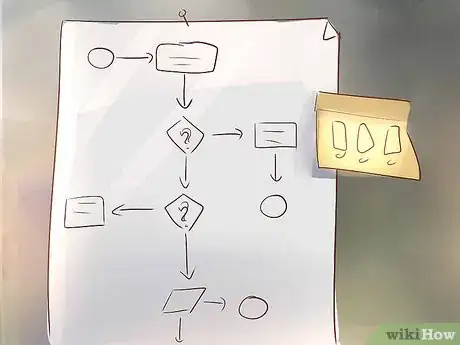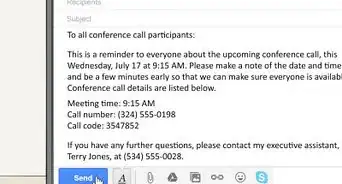This article was co-authored by Dave Labowitz. Dave Labowitz is a Business Coach who helps pre-entrepreneurs, solopreneurs/entrepreneurs, and team leaders start, scale, and lead their businesses and teams. Before beginning his coaching career, Dave was a startup executive who spent over a decade building high-growth companies. Dave’s “path less traveled” life includes adventures such as dropping out of high school, co-authoring a book in the Smithsonian Institute, and getting his MBA at Pepperdine’s Graziadio Business School.
There are 7 references cited in this article, which can be found at the bottom of the page.
wikiHow marks an article as reader-approved once it receives enough positive feedback. This article received 19 testimonials and 100% of readers who voted found it helpful, earning it our reader-approved status.
This article has been viewed 304,804 times.
There are two types of change management plans. One addresses the impact of change on an organization, easing the transition. The other tracks changes to a single project, creating a clear record of product tweaks or alterations to the project scope. Both of these plans aim to communicate what needs to be done clearly and accurately.
Steps
Writing a Plan to Manage Organizational Change
-
1Demonstrate the reasons for the change. List factors that led to the decision to change, such as performance gaps, new technology, or a shift in the organization's mission.
- One approach is to describe the current situation of the organization, and the future situation this plan intends to create.[1]
-
2Define the type and scope of change. Briefly describe the expected nature of the change management project. Determine whether this will affect job roles, process changes, policy changes, and/or structural organization. List the departments, workgroups, systems, or other components that may change.[2]Advertisement
-
3Describe stakeholder support. List all stakeholders affected by the plan, for example, senior management, project manager, project sponsor, end-users, and/or employees affected by the change. For each one, write whether the stakeholder supports the change.
- Consider a chart to communicate this clearly and succinctly. One possible template lists Awareness, Degree of Support, and Influence for each stakeholder, rated on a scale of High/Medium/Low.
- If possible, conduct one-on-one interviews to gauge support.
-
4Create a change management team. This team is responsible for communicating with all stakeholders, listening to concerns, and ensuring that the change goes as smoothly as possible. Choose people with high credibility in the organization, and good communication skills.[3]
- This should include a change sponsor at the senior executive level.[4] Stress that this involves active work promoting the changes, not just a sign-off on the plan.
-
5Develop an approach with organization management. Complete support from organization heavyweights is critical for the success of the change. Allow each senior staff member to provide feedback on the change, and work with each one to create an active role in demonstrating and championing the changes.[5]
-
6Draw up a plan for each stakeholder. For each stakeholder, including those who support the change, assess the risks and concerns involved. Assign the change management team the task of addressing these concerns.
-
7Create a communication plan. Communication is the most important component of change management. Communicate frequently with every person affected. Reinforce the reasons behind the change, and the benefits it will bring.
- Stakeholders should receive personal, two-way communication. Face to face meetings are essential.[6]
- Communication should come from the high-level change sponsor, from the direct supervisor of each employee, and any additional spokespersons the stakeholder trusts.[7] All communication should have a consistent message.
- Once the changes have been communicated to all the stakeholders within the organization, then implementation of the changes needs to take place.
-
8Track resistance. There is always resistance to change. This happens on the individual level, so communicate with stakeholders personally to discover the cause. Monitor grievances so the change management team can address them. These concerns commonly include:[8]
- No motivation to change, or no sense of urgency
- No understanding of the bigger picture or why the change is necessary
- Lack of input in the process
- Uncertainty concerning job security, future role, or future job requirements and skills
- Failure of management to meet expectations concerning change implementation or communication
-
9Address roadblocks. Many grievances should be met by an increase in communication or a change in a communication strategy that addresses specific issues. Others require additional approaches, which may be included in your plan or left to the change management team to implement as necessary. Consider which of these is right for your organization:
- For any change in job roles or process, make employee training a top priority.[9]
- If you expect low morale or a stressful transition, alleviate this with a company event or employee perks.[10]
- If stakeholders are not motivated to change, provide incentives.[11]
- If stakeholders feel left out of the loop, hold a meeting to gather feedback and consider alterations to the plan.
Tracking Changes to Any Project
-
1Define change management roles. List the roles that will be assigned for this project. Describe the responsibilities and necessary skills for each role. At a minimum, include a project manager to enact changes on a day-to-day level, and a project sponsor to track overall progress and make high-level change management decisions.
- For broad projects in a large organization, you may need to divide the project management role among several people with specialized knowledge.
-
2Consider a change control board. Software projects typically include a Change Control Board, made up of representatives from each stakeholder group. This board approves change requests instead of the project manager and communicates the decisions to stakeholders. This approach works well for projects with many stakeholders, and projects which may need frequent reevaluation of the scope and baseline goals.
-
3Create a process for enacting change requests. Once someone on the project team identifies a step forward, how does it go from idea to reality? Describe this process here, as agreed upon by the team. Here's an example:[12]
- Team member fills out a Change Request form and sends it to the project manager.
- Project manager enters form into the Change Request Log, and updates this log as requests are implemented or rejected.
- Manager assigns team members to write a more specific plan and to estimate the effort required.
- Project manager sends plan to the project sponsor for approval or rejection.
- Change is implemented. Stakeholders are informed of progress frequently.
-
4Create a change request form. The following data should be included with every change request and entered in the changelog:[13]
- Date of change request
- Change request number, assigned by the project manager
- Title and description
- Submitter name, email, and phone number
- Priority (High, Medium, or Low). Urgent change management plans may require specific deadlines.
- Product and version number (for software projects)
-
5Add additional information to the changelog. The changelog must also track decisions and implementation. Besides the information copied from the change request form, you'll need space for the following:
- Mark of approval or rejection
- Signature of the person approving or rejecting the request
- Change implementation deadline
- Change completion date
-
6Track major decisions. In addition to the day-to-day changelog, the project may benefit from a record of major decisions. This record may make it easier to track long term projects or projects that undergo leadership changes. This record can also guide communication with clients or senior management. For each change in deadlines, project scope or requirements, priority levels, or strategy, including the following information:[14]
- Who made the decision
- When the decision was made
- A summary of the reasons behind the decision, and the process used to reach it. Attach any documents related to this process.
Expert Q&A
-
QuestionIs a change management team required in small business?
 Dave LabowitzDave Labowitz is a Business Coach who helps pre-entrepreneurs, solopreneurs/entrepreneurs, and team leaders start, scale, and lead their businesses and teams. Before beginning his coaching career, Dave was a startup executive who spent over a decade building high-growth companies. Dave’s “path less traveled” life includes adventures such as dropping out of high school, co-authoring a book in the Smithsonian Institute, and getting his MBA at Pepperdine’s Graziadio Business School.
Dave LabowitzDave Labowitz is a Business Coach who helps pre-entrepreneurs, solopreneurs/entrepreneurs, and team leaders start, scale, and lead their businesses and teams. Before beginning his coaching career, Dave was a startup executive who spent over a decade building high-growth companies. Dave’s “path less traveled” life includes adventures such as dropping out of high school, co-authoring a book in the Smithsonian Institute, and getting his MBA at Pepperdine’s Graziadio Business School.
Business Coach Not necessarily! Change management plans are definitely necessary for larger companies where a lot of different departments and teams are going to be affected. However, a smaller start-up organization could probably fit all of their employees into a single room for a meeting rather than creating a separate change management team.
Not necessarily! Change management plans are definitely necessary for larger companies where a lot of different departments and teams are going to be affected. However, a smaller start-up organization could probably fit all of their employees into a single room for a meeting rather than creating a separate change management team. -
QuestionWhat are the key elements of a change management plan?
 Dave LabowitzDave Labowitz is a Business Coach who helps pre-entrepreneurs, solopreneurs/entrepreneurs, and team leaders start, scale, and lead their businesses and teams. Before beginning his coaching career, Dave was a startup executive who spent over a decade building high-growth companies. Dave’s “path less traveled” life includes adventures such as dropping out of high school, co-authoring a book in the Smithsonian Institute, and getting his MBA at Pepperdine’s Graziadio Business School.
Dave LabowitzDave Labowitz is a Business Coach who helps pre-entrepreneurs, solopreneurs/entrepreneurs, and team leaders start, scale, and lead their businesses and teams. Before beginning his coaching career, Dave was a startup executive who spent over a decade building high-growth companies. Dave’s “path less traveled” life includes adventures such as dropping out of high school, co-authoring a book in the Smithsonian Institute, and getting his MBA at Pepperdine’s Graziadio Business School.
Business Coach Communication and implementation! Communication is all about clearly explaining what is changing and why. From there, you'd make sure to have enough conversations with your team so you can get them on board with the new vision. Once your whole team is brought in, jump into the implementation side of things—that's just about putting a really good project plan together to get from where you are to where you want to be. Make sure that deadlines and accountabilities are clear, and that everyone has the resources and contacts they need to move forward.
Communication and implementation! Communication is all about clearly explaining what is changing and why. From there, you'd make sure to have enough conversations with your team so you can get them on board with the new vision. Once your whole team is brought in, jump into the implementation side of things—that's just about putting a really good project plan together to get from where you are to where you want to be. Make sure that deadlines and accountabilities are clear, and that everyone has the resources and contacts they need to move forward.
References
- ↑ http://www.nrm.wa.gov.au/media/10528/change_management_plan_workbook_and_template.pdf
- ↑ http://www.nrm.wa.gov.au/media/10528/change_management_plan_workbook_and_template.pdf
- ↑ http://www.cedmag.com/article-detail.cfm?id=10925388
- ↑ http://www.mindtools.com/pages/article/newPPM_87.htm
- ↑ http://www.cedmag.com/article-detail.cfm?id=10925388
- ↑ http://www.doa.nc.gov/procurement/documents/reports/ChangeManagementCommunicationsPlan_2011.pdf
- ↑ http://www.change-management.com/tutorial-communication-with-without.htm
- ↑ http://www.doa.nc.gov/procurement/documents/reports/ChangeManagementCommunicationsPlan_2011.pdf
- ↑ http://www.cedmag.com/article-detail.cfm?id=10925388
- ↑ http://www.cedmag.com/article-detail.cfm?id=10925388
- ↑ http://www.doa.nc.gov/procurement/documents/reports/ChangeManagementCommunicationsPlan_2011.pdf
- ↑ http://www2.cdc.gov/cdcup/library/templates/cdc_up_change_management_plan_template.doc
- ↑ http://www2.cdc.gov/cdcup/library/templates/cdc_up_change_management_plan_template.doc
- ↑ http://www.liquidplanner.com/blog/how-should-a-project-manager-capture-decisions/
About This Article
To write a change management plan for an organization, start by listing the contributing factors, such as performance gaps or new technology. Next, describe the change and how it affects job roles, procedures, policies, and structural organization. Then, list the departments, groups, and stakeholders affected by the plan. Create a change management team to ensure a smooth transition, and devise a communication plan to reinforce the reasons behind the change! For tips on tracking changes to any project, read on!













































































